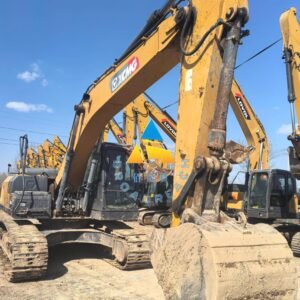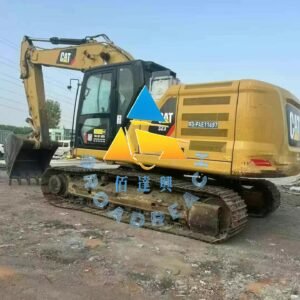BroadReach Construction Machinery Co., Ltd

Breathing New Life into a Used Hydraulic Excavator: A Comprehensive Rebuild Guide
When it comes to heavy machinery, buying a used excavator can be a smart and cost-effective choice. However, ensuring that the used hydraulic excavator you purchase is in good condition is essential to avoid expensive repairs down the road. If you’ve already purchased a used hydraulic excavator for sale, or you’re considering a rebuild, this guide will walk you through the process of revamping your machine to restore its power and efficiency.
Step 1: Evaluating the Condition of the Excavator
Before diving into any rebuild, it’s crucial to evaluate the condition of the used excavator. If you’ve recently bought a second-hand model, inspecting key components will give you an idea of what needs attention:
- Frame and Structure: Check for cracks or corrosion that might compromise the machine’s integrity.
- Engine: A detailed engine assessment will help identify issues such as oil leaks or performance inconsistencies.
- Hydraulic System: One of the most vital systems in a hydraulic excavator, make sure to test for leaks and damage in the hydraulic pump and cylinders.
- Tracks and Undercarriage: The mobility of your excavator depends heavily on the undercarriage. Look for any worn-out or misaligned parts.
- Cab and Controls: Ensure the interior of the cab is in good shape and that all controls function properly for safe operation.
After assessing the condition, you’ll have a clear idea of whether the machine is worth rebuilding or if it would be more cost-effective to find a new used hydraulic excavator for sale.
Step 2: Identifying Critical Components That May Need Replacement or Repair
Certain parts of your used excavator will inevitably show signs of wear and may require replacement. When rebuilding, focus on the following critical components:
- Engine and Transmission: If your excavator’s engine is underperforming, it may need to be overhauled or replaced entirely.
- Hydraulic System: The hydraulic pump and cylinders should be tested for pressure loss or damage. These parts are essential to your machine’s performance.
- Tracks and Undercarriage: Worn tracks or undercarriage components can lead to instability and reduced mobility, so consider replacing these parts.
- Electrical System: Check the wiring, battery, and fuses for any electrical failures or corrosion.
- Cab and Comfort Features: Upgrading the operator’s cabin can improve safety and efficiency, so replacing old seats, improving air conditioning, or enhancing visibility is recommended.
By replacing or repairing these essential parts, you can significantly extend the lifespan of your excavator, bringing it back to nearly-new condition.
Step 3: The Tools and Equipment Required for a Full Rebuild
To effectively rebuild your used hydraulic excavator, you’ll need access to specialized tools:
- Hydraulic Tools: These are necessary for repairing or replacing hydraulic pumps, hoses, and cylinders.
- Welding Equipment: Use welding equipment for structural repairs on the frame and body of the excavator.
- Heavy Duty Lifting Equipment: Cranes, hoists, and forklifts will be required to disassemble large parts like the engine or undercarriage.
- Diagnostic Equipment: Modern diagnostic tools will help you assess engine health and hydraulic system pressure.
- Basic Hand Tools: Wrenches, pliers, and screwdrivers will be needed for smaller tasks throughout the rebuild process.
These tools will ensure that the rebuild is done efficiently and safely.
Step 4: Best Practices for Testing and Ensuring the Machine Operates Efficiently Post-Rebuild
Once the rebuild is complete, it’s time to test your used hydraulic excavator to ensure everything is operating as it should. Here’s how to test:
- Hydraulic Pressure Test: Ensure the hydraulic system is operating at the right pressure with no leaks in hoses or cylinders.
- Engine Performance Test: Monitor the engine to ensure it’s running smoothly, with proper fuel efficiency and low emissions.
- Track and Undercarriage Test: Check for stability and smooth movement, ensuring no issues with the undercarriage or tracks.
- Control System Check: Test the responsiveness of the machine’s controls, including the joystick and pedals.
- Safety and Comfort Test: Ensure that safety features like seatbelts and alarms are in place, and that the operator’s cabin is comfortable.
By performing thorough tests, you’ll confirm that your rebuilt hydraulic excavator is ready for heavy-duty work.
Step 5: Providing Insights on Cost and Time Estimates for the Process
Rebuilding a used hydraulic excavator for sale can be a significant investment. Here’s an estimate of what to expect:
- Time Estimate: Depending on the condition of the excavator, the rebuild process could take anywhere from a few weeks to several months.
- Cost Estimate: Rebuilding a hydraulic excavator can cost between $10,000 to $50,000, depending on the extent of the repairs needed. However, the cost of a rebuild is still much more affordable compared to buying a brand-new excavator.
While the rebuild process requires time and money, the end result is a machine that performs like new, saving you the expense of purchasing a new excavator.
Conclusion
If you’ve bought a used hydraulic excavator for sale or are considering doing so, rebuilding it can significantly extend its lifespan and enhance its performance. With the right tools, expert knowledge, and a step-by-step approach, you can transform your used excavator into a powerful, reliable machine. Whether you’re working with a machine that’s seen better days or looking to optimize your equipment, a rebuild is a cost-effective way to breathe new life into your excavator and keep it running at peak performance for years to come.






